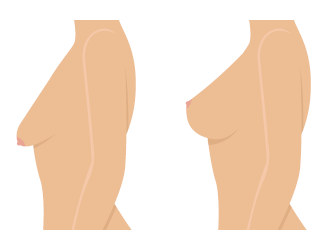

Breast Lift
(Mastopexy)
Mastopexy, known commonly as breast lift surgery, aims to elevate the nipple and areola to a more youthful position, tighten the gland and remove excess skin, in order to obtain lifted and harmoniously shaped breast.
Breast ptosis is the weighing of the breast gland causing a stretching of the surrounding skin and a global sagging of the breast. The breast lies in a too low position and is flattened in its upper part. Breast ptosis can be present from the start, or appear after weight loss or pregnancy with breast feeding. It can be isolated (pure ptosis) or associated to mammary hypertrophy. Conversely, there can be a ptosis with a small breast (hypoplasia or hypotrophy). The operation shapes the breast by stretching the skin envelope and concentrating the glandular tissue. The gland is concentrated and put back in proper position, after removal of the skin excess, thus placing the nipple and areola back in a youthful position.
The skin incisions are sutured and cause scars. When the ptosis is very severe, the scars have an anchor shape, with a peri-areolar scar between the brown and white skin, a vertical scar from the areola down to the bottom fold of the breast (infra-mammary fold). The length of the horizontal scar is proportional to the severity of the sagging.
When the ptosis is milder, an isolated vertical scar method can be used, thus avoiding the horizontal scar in the bottom fold and leaving only the peri-areolar and vertical scars. In some very mild breast ptosis, it is possible to use a concentric (or doughnut) mastopexy, which leaves only one scar around the areola.
Finally, in case of a too small breast volume (mammary hypoplasia), breast implants can be added, to restore a satisfying breast volume. In this case, it is usually possible to remove the excess skin around the areola and reduce the scar only to a peri-areolar scar.
Mastopexy may be performed from the end of adolescence, when growth has ended, throughout life. A further pregnancy or breast-feeding are possible, but we advise to wait for a minimum of 6 months after surgery.
Before the operation
A preoperative check-up is conducted. You will meet the anesthesiologist in consultation at latest, 48 hours prior to surgery. Besides the usual preoperative examinations, you will be asked to have a mammogram and/or a breast ultra-sonography.
No medication containing aspirin will be taken for 10 days before surgery.
Hospital stay and type of anesthesia
Mastopexy is usually performed under general anesthesia. You will be asleep through the entire operation.
The procedure
Techniques are adapted to every new case, in order to obtain the best possible results. However, there are common principles:
- All removed tissues are sent to a special laboratory for microscopic examination (histological exam).
- After surgery, you will wear a “bra-like” dressing with elastic bandage.
Depending on the severity of the ptosis, the operation can last two to three hours
After the operation
In most cases, postoperative pain is moderate and usually relieved by ordinary pain medication. Swelling (edema), bruising and pain, when lifting arms upwards are common symptoms.
Your dressing will be removed after 2 days and replaced with a lighter one, resembling a custom-made bra. You will leave the hospital 1 to 2 days after the operation and attend consultation 2 to 3 days later. You will then be wearing a surgical bra, which size will have been determined in the hospital, prior to your leaving. You should wear the surgical bra day and night for at least one month after surgery.
It is often possible to return to work within a week or so, depending on the job. You can resume most of your normal activities, including some form of mild exercise, after several weeks. You are advised to wait for one to two months before fully practising any sports.
Picture Gallery




The result
It can be best appreciated six months to one year after the procedure: the breasts are usually harmoniously shaped, symmetrical and have a natural shape. Besides the physical improvement, this operation usually has a positive effect on weight control, exercise, clothing and psychological health.
However, before this final outcome, one should be patient, wait for scars to slowly fade, and accept a regular follow-up every 3 months during the following year. You should also bear in mind that scarring is a patient-related process.
The operated breast remains natural and sensitive and responds normally to hormonal shifts.
Imperfect results
The main concern is scars, which will be closely looked after by your surgeon. They can often be red and swollen for 2-3 months. Then, they slowly fade away and with time, become moderately visible. However, they can remain widened, clear or conversely, brown. It must be stressed that even though they usually fade away with time, they never completely disappear.
You may also notice a breast asymmetry, regarding volume, height, size or nipple orientation. All these imperfections can be corrected secondarily, after one or two years.
Possible complications
Mastopexy, even if performed for aesthetic reasons, is a genuine surgical procedure, with the consequent risks related to all medical acts. There are surgical and aesthetic complications. Concerning anesthesia, the anesthesiologist will inform you about all the anesthetic risks. You must be aware that anesthesia can sometimes cause unpredictable body reactions that can be difficult to control. The presence of an experienced anesthesiologist, in a surgical environment, means that the risks are practically statistically negligible.
Complications, even though they are rare after a properly performed operation, may occur: some are general, inherent to every surgical act, others are local and most commonly occur in very large breasts. Among possible complications are the following:
- Infection- it can be treated with drainage and antibiotics.
- Blood clots (haematomas) are quite rare but can occur. They can be evacuated.
- Localized skin or gland necrosis are rare with modern techniques. They can cause delayed healing.
- Numbness of the nipples may be observed. It is usually transient and most patients recover normal nipple feeling after 6 to 18 months.
Most important to consider is the evolution of scars. These may sometimes become hypertrophic or bumpy (keloid), in a totally unpredictable manner, thus compromising the final aesthetic outcome. Such pathological scars may require long and specific local treatments. In most cases however, this operation when correctly planned and executed, does offer very satisfying results in terms of comfort and wellbeing.
My Way …. “Metron Ariston”
The Golden Ratio of The Breast
Getting harmonious results in Plastic Surgery is much more than a “nip-tuck”!
It is the accrual of long-term experience in conjunction with applied research!
Our longitudinal study (Moufarrege & Dionyssopoulos) drew on the observation of thousands of breast shapes along our Plastic Surgery experience. We concluded that breast dimensions and ratios of these dimensions are important factors to take into consideration in order to obtain harmonious results in mammaplasties.
THE GOLDEN RATIOS OF THE BREAST, as calculated in our study are:
− In lateral view, Height over Projection H/P ≥ 2. A lower ratio is acceptable until H/P≥1.5.
− In frontal view Height over Width should go from 0.7 to 1.3 i.e. 0.7≤H/W≤1.3.
This webpage aims to provide some information about the subject. Individual patient circumstances may differ, which might alter both the advice and course of therapy given to you by your doctor.
Source:
American Society of Plastic Surgeons, British Association of Plastic, Reconstructive and Aesthetic Surgeons, French Society of Plastic, Reconstructive and Aesthetic Surgery
